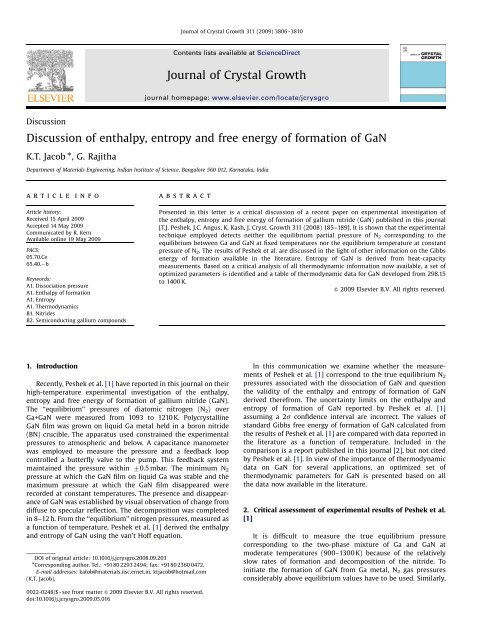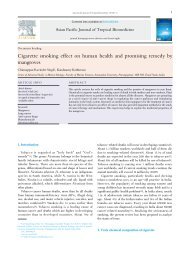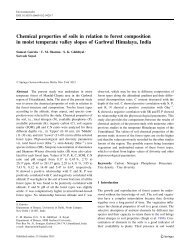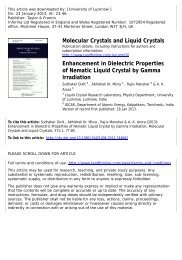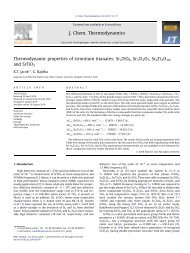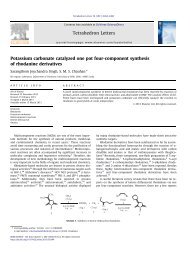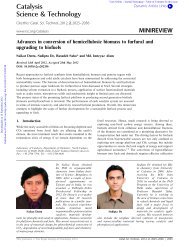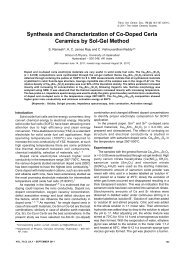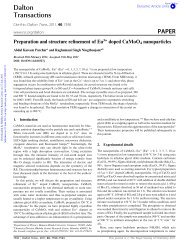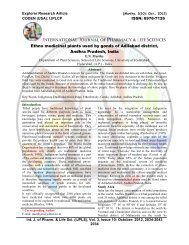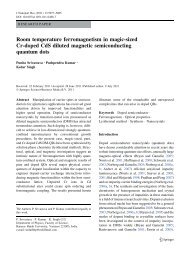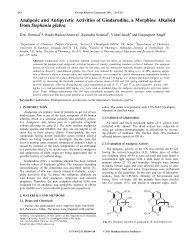Discussion of enthalpy, entropy and free energy of formation of GaN ...
Discussion of enthalpy, entropy and free energy of formation of GaN ...
Discussion of enthalpy, entropy and free energy of formation of GaN ...
Create successful ePaper yourself
Turn your PDF publications into a flip-book with our unique Google optimized e-Paper software.
ARTICLE IN PRESSK.T. Jacob, G. Rajitha / Journal <strong>of</strong> Crystal Growth 311 (2009) 3806–3810 3807ln (P N2/ P°)Peshek "equilibrium"Formation <strong>of</strong> <strong>GaN</strong>Equilibrium line<strong>of</strong> the slow kinetics <strong>of</strong> decomposition, the minimum N 2 pressurefor stable <strong>GaN</strong> would be well below the equilibrium dissociationpressure <strong>of</strong> N 2 . It can be argued that this upper pressure limitidentified by Peshek et al. [1] as the minimum pressure for stable<strong>GaN</strong> actually marks the onset <strong>of</strong> decomposition <strong>of</strong> metastable<strong>GaN</strong>. The true equilibrium must lie well above it. At ambientpressure <strong>of</strong> N 2 (0.1 MPa), Peshek et al. [1] varied the temperatureto identify the limit between ‘‘stability’’ <strong>and</strong> ‘‘instability’’.Since Peshek et al. [1] experimentally identified two pressuremarkers corresponding to the onset <strong>and</strong> completion <strong>of</strong> the <strong>GaN</strong>decomposition process <strong>and</strong> derived their so-called ‘‘equilibrium’’as a mean <strong>of</strong> these, their data can not be considered reliable. Theyapproached ‘‘equilibrium’’ only in one direction. They did notattempt reversal (<strong>formation</strong> <strong>of</strong> <strong>GaN</strong>). True equilibrium is bestidentified by approaching it from both directions. They actuallymeasured the limit between metastability <strong>and</strong> instability. For thisreason, their data are systematically displaced to lower pressuresor more negative st<strong>and</strong>ard Gibbs energies <strong>of</strong> <strong>formation</strong> <strong>of</strong> <strong>GaN</strong>.3. Statistical analysis <strong>of</strong> dataDecomposition <strong>of</strong> <strong>GaN</strong>(max. P N2for decomp.)Min. P N2for metastable <strong>GaN</strong>1 / T (1/K)Fig. 1. Schematic representation <strong>of</strong> nitrogen partial pressures for <strong>formation</strong> <strong>and</strong>decomposition <strong>of</strong> <strong>GaN</strong> as a function <strong>of</strong> reciprocal <strong>of</strong> absolute temperature. Trueequilibrium line is drawn assuming symmetrical hysteresis. Pressures correspondingto the measurements <strong>of</strong> Peshek et al. [1] are illustrated schematically.P 0 =0.1 MPa is the st<strong>and</strong>ard pressure.to decompose <strong>GaN</strong>, pressures significantly below equilibrium haveto be applied as shown schematically in Fig. 1. The N 2 pressurehysteresis reduces with increasing temperature. Assuming that thehysteresis is symmetrical, the equilibrium curve may betentatively placed midway between the pressure required for<strong>formation</strong> <strong>and</strong> that corresponding to the decomposition atconstant temperature. This is not necessarily a good assumptionbecause the kinetic constants for <strong>formation</strong> <strong>and</strong> decomposition aregenerally expected to be different. Nevertheless, in the absence <strong>of</strong> aclear underst<strong>and</strong>ing <strong>of</strong> the kinetic processes, the symmetryapproximation is the best that can be made. It is clear from Fig.1 that <strong>GaN</strong> can be retained metastably below its equilibriumdissociation pressure for periods that exceed the laboratorymeasurement time scales.Peshek et al. [1] did not measure the N 2 pressure required forthe <strong>formation</strong> <strong>of</strong> <strong>GaN</strong>. Rather, they reduced the N 2 pressuregradually at constant temperature, <strong>and</strong> recorded the minimum N 2pressure at which <strong>GaN</strong> was stable in the experimental time frame(24–36 h), <strong>and</strong> the maximum N 2 pressure at which the <strong>GaN</strong> filmcompletely disappeared. Presumably, in the intervening pressurerange partial decomposition <strong>of</strong> <strong>GaN</strong> would have occurred. It is tobe noted that the minimum N 2 pressure for observing stable <strong>GaN</strong>film is considerably higher than the maximum pressure for thedisappearance <strong>of</strong> the film. Peshek et al. [1] identified equilibriummidway between these two pressures as shown in Fig. 1. BecausePeshek et al. [1] ‘‘conservatively’’ associate the pressure ortemperature range for transiting from ‘‘stable’’ to ‘‘unstable’’domain for <strong>GaN</strong>, displayed in Fig. 1 <strong>of</strong> their paper, with a 2suncertainty or 95% confidence interval. It is difficult to underst<strong>and</strong>how these kinetically determined ranges can be associated withstatistical uncertainty. Peshek et al. [1] do not present numericalvalues for their dissociation pressures or temperature. The dataare presented in their Fig. 1, which is a plot <strong>of</strong> 0:5 R ln P N2 versusthe reciprocal <strong>of</strong> absolute temperature. From the slope they0derived DH f,<strong>GaN</strong> = 1,65,000716,000 J/mol [1]. In view <strong>of</strong> thenarrow temperature range (120 K) <strong>and</strong> the relatively largescatter in the data, the uncertainty limit on the <strong>enthalpy</strong> <strong>of</strong><strong>formation</strong> appears to be low. The least-squares linear regressionanalysis <strong>of</strong> the data presented in the figure, giving equal weight toall the points, gives the expression:0:5 R lnðP N2 Þð2:179ÞðkJ=mol KÞ1; 65; 035ð33; 440Þ¼ 138:16ð29:18Þ(1)Twhere the uncertainty estimates on each term correspond toeither the st<strong>and</strong>ard deviation or the st<strong>and</strong>ard error estimates (s).00Hence, DH f,<strong>GaN</strong> = 1,65,035766,880 J/mol, <strong>and</strong> DS f,<strong>GaN</strong> =138.16758.36 J/mol K for 2s confidence interval. Although the <strong>enthalpy</strong><strong>and</strong> <strong>entropy</strong> <strong>of</strong> <strong>formation</strong>s derived from the equation are close tovalues reported by Peshek et al. [1], the uncertainties are morethan four times the values given by them for the same (95%)confidence interval. Given the large uncertainty in the <strong>enthalpy</strong> <strong>of</strong><strong>formation</strong>, the result cannot be used to differentiate among thecalorimetric data [3–5] as suggested by Peshek et al. [1].4. Comparison <strong>of</strong> data4.1. Gibbs <strong>free</strong> <strong>energy</strong> <strong>of</strong> <strong>formation</strong> <strong>of</strong> <strong>GaN</strong>The most direct <strong>and</strong> reliable thermodynamic quantity that canbe obtained from dissociation pressure measurements is theGibbs <strong>free</strong> <strong>energy</strong> <strong>of</strong> <strong>formation</strong> <strong>of</strong> <strong>GaN</strong>. The values obtained fromthe measurements <strong>of</strong> Peshek et al. [1] are compared with otherpublished data [2,6–10] in Fig. 2. Their values are the mostnegative compared to all the other direct Gibbs <strong>energy</strong>measurements at high temperature for reasons outlined inSection 2. In partial justification <strong>of</strong> their results, Peshek et al. [1]cited the agreement between the <strong>enthalpy</strong> <strong>of</strong> <strong>formation</strong> <strong>of</strong> <strong>GaN</strong>
ARTICLE IN PRESS3808K.T. Jacob, G. Rajitha / Journal <strong>of</strong> Crystal Growth 311 (2009) 3806–3810ΔG f ° (kJ/mol)100806040200-20-40<strong>GaN</strong>Madar et al.(dissociation pressure)Unl<strong>and</strong> et al.(dissociationtemperature)Jacob et al.(emf)Karpinski et al.(dissociation pressure)* with fugacity correction* without fugacity correctionRecommended ValuesThurmond <strong>and</strong> Loganminimum NH 3 for synthesisNH 3 in exit stream duringsynthesisNH 3 produced by reactionPeshek et al. <strong>of</strong> H 2 with <strong>GaN</strong>(dissociation pressure)Calorimetric Δ H° 298 <strong>of</strong> Ranade et al.combined with thermal data.-609001000 1100 1200 1300 1400 1500 1600 1700 1800 1900 2000T (K)Fig. 2. Comparison <strong>of</strong> reported values <strong>of</strong> st<strong>and</strong>ard Gibbs <strong>energy</strong> <strong>of</strong> <strong>formation</strong> <strong>of</strong> <strong>GaN</strong>.derived from their measurements <strong>and</strong> the recent calorimetricmeasurements [4,5]. This agreement is fortuitous; accuratemeasurement <strong>of</strong> dissociation pressure as a function <strong>of</strong> temperaturemust give simultaneously correct values for both <strong>enthalpy</strong> <strong>and</strong><strong>entropy</strong> <strong>of</strong> <strong>formation</strong>. One cannot extract the correct value <strong>of</strong><strong>enthalpy</strong> <strong>and</strong> incorrect value <strong>of</strong> <strong>entropy</strong>.Madar et al. [7] <strong>and</strong> Karpinski et al. [8] measured thedissociation pressure <strong>of</strong> <strong>GaN</strong> at high temperatures <strong>and</strong> nitrogenpressures well above atmospheric. Madar et al. [7] placed a vapordeposited<strong>GaN</strong> layer on sapphire in the hot spot <strong>of</strong> an internallyheated pressure vessel at temperatures up to 1523 K. A series <strong>of</strong>annealing treatments were given at different N 2 pressures toidentify the dissociation pressure. Formation <strong>of</strong> Ga droplets on thesurface signaled decomposition. Using microcrystalline powders<strong>of</strong> <strong>GaN</strong>, Karpinski et al. [8] made more extensive measurements attemperatures up to 1913 K. Karpinski <strong>and</strong> Porowski [9] derivedGibbs energies for <strong>formation</strong> <strong>of</strong> <strong>GaN</strong> from the high-pressure datausing fugacity correction. In Fig. 2 the st<strong>and</strong>ard Gibbs energies <strong>of</strong><strong>formation</strong> <strong>of</strong> <strong>GaN</strong> derived from the high-pressure studies <strong>of</strong>Karpinski et al. [8] with <strong>and</strong> without fugacity correction areshown. Since there is significant uncertainty in the fugacity valuesat high pressures, the most reliable Gibbs <strong>energy</strong> data from themeasurements <strong>of</strong> Karpinski et al. [8] are in the lower end <strong>of</strong> theirtemperature range, where the magnitude <strong>of</strong> fugacity correction isrelatively small. The thin film <strong>of</strong> <strong>GaN</strong> on sapphire used by Madaret al. [7] was probably associated with higher <strong>free</strong> <strong>energy</strong> than themicrocrystalline powder used by Karpinski et al. [8].Thurmond <strong>and</strong> Logan [6] used the ratio <strong>of</strong> partial pressures <strong>of</strong>NH 3 to H 2 in gas mixture at ambient pressure as an indicator <strong>of</strong> N 2partial pressure. They measured the minimum NH 3 pressure in H 2required for the synthesis <strong>of</strong> <strong>GaN</strong> from Ga, NH 3 concentration inthe exit stream during synthesis <strong>and</strong> the concentration <strong>of</strong> NH 3produced by the reduction <strong>of</strong> <strong>GaN</strong> by H 2 . The st<strong>and</strong>ard Gibbsenergies <strong>of</strong> <strong>formation</strong> <strong>of</strong> <strong>GaN</strong> calculated from the three sets <strong>of</strong> dataare shown by separate symbols in Fig. 2. The measurementsprovide upper <strong>and</strong> lower limits for <strong>free</strong> <strong>energy</strong>. Thurmond <strong>and</strong>Logan [6] suggested that the values derived reduction measurementswere close to equilibrium. Comparison <strong>of</strong> their results withthe data <strong>of</strong> Karpinski et al. [8] in the overlapping temperaturerange supports the suggestion. Peshek et al. [1] claim thatreduction <strong>of</strong> <strong>GaN</strong> by H 2 to form NH 3 does not happen in thetemperature range <strong>of</strong> their experiments contrary to the observation<strong>of</strong> Thurmond <strong>and</strong> Logan [6]. Based on our experience thereduction does proceed <strong>and</strong> NH 3 can be detected when the flowrate <strong>of</strong> H 2 is low. Perhaps at relatively high flow rates used byPeshek et al. [1], the concentration <strong>of</strong> NH 3 was below theirdetection limit. At higher flow rates used by Peshek et al. [1], thegas phase may not even be in thermal equilibrium with thecondensed phases, let alone chemical equilibrium.Jacob et al. [10] used a solid-state electrochemical technique,using single-crystal CaF 2 as the electrolyte, to measure thest<strong>and</strong>ard <strong>free</strong> <strong>energy</strong> <strong>of</strong> <strong>formation</strong> <strong>of</strong> <strong>GaN</strong> with relatively highaccuracy (7465 J/mol) from 875 to 1125 K. Unl<strong>and</strong> et al. [2]measured the dissociation temperature <strong>of</strong> <strong>GaN</strong> in pure nitrogen atambient pressure as 1110710 K using two different thermogravimetricmethods, dynamic oscillation thermogravimetric analysis(TGA) <strong>and</strong> isothermal stepping TGA.As seen in Fig. 2, four independent measurements <strong>of</strong> the <strong>free</strong><strong>energy</strong> <strong>of</strong> <strong>GaN</strong> (Jacob et al. [10], Unl<strong>and</strong> et al. [2], decompositionstudies <strong>of</strong> Thurmond <strong>and</strong> Logan [6] in H 2 <strong>and</strong> N 2 dissociationstudies <strong>of</strong> Karpinski et al. [8] at lower pressures) covering in all alarge temperature range from 875 to 1500 K are in goodagreement. These results taken together can be represented bythe equation:DG o f ð2520ÞðJ=molÞ ¼ 1; 30; 297ð3534Þþ116:8ð3:06Þ T (2)This equation represents the best in<strong>formation</strong> on Gibbs <strong>energy</strong> <strong>of</strong><strong>formation</strong> now available.4.2. St<strong>and</strong>ard <strong>entropy</strong> <strong>and</strong> <strong>entropy</strong> <strong>of</strong> <strong>formation</strong> <strong>of</strong> <strong>GaN</strong>The most accurate values <strong>of</strong> <strong>entropy</strong> <strong>of</strong> crystalline <strong>GaN</strong> isobtained by integrating the curve <strong>of</strong> (C P /T) versus temperaturefrom 0 K to the desired temperature. Fortunately, both low- <strong>and</strong>high-temperature heat-capacity data are available for <strong>GaN</strong>. Theavailable data have been critically analyzed by Jacob et al. [10] <strong>and</strong>the <strong>entropy</strong> <strong>of</strong> <strong>GaN</strong> evaluated as a function <strong>of</strong> temperature. LowtemperatureC P data <strong>of</strong> Demidenko et al. [11] from 55 to 300 K <strong>and</strong><strong>of</strong> Koshchenko et al. [12] from 5 to 60 K were used to evaluate the
ARTICLE IN PRESSK.T. Jacob, G. Rajitha / Journal <strong>of</strong> Crystal Growth 311 (2009) 3806–3810 3809Table 1Recommended thermodynamic properties <strong>of</strong> <strong>GaN</strong> from 298.15 to 1400 K.T (K) C 0 P (J/mol K) H o 0T H 298.15(J/mol) S 0 0T S 298.15 (J/mol K) S 0 T (J/mol K) DS T (J/mol K) DH 0 f (kJ/mol) DG 0 f (kJ/mol)298.15 35.30 0 0 34.120 102.458 129.289 98.741300 35.40 65 0.219 34.339 102.493 129.301 98.553302.9 35.56 168 0.560 34.680 102.547 129.319 98.258302.9 35.56 168 0.560 34.680 121.002 134.909 98.258400 40.00 3848 11.067 45.187 122.231 135.324 86.432500 43.36 8024 20.372 54.492 122.227 135.313 74.199600 45.90 12492 28.512 62.632 121.679 135.010 62.002700 47.86 17184 35.741 69.861 120.900 134.500 49.870800 49.43 22051 42.238 76.358 120.026 133.844 37.823900 50.69 27059 48.135 82.255 119.129 133.080 25.8641000 51.72 32181 53.530 87.650 118.240 132.237 13.9971100 52.57 37397 58.501 92.621 117.372 131.326 2.2171200 53.28 42690 63.106 97.226 116.532 130.363 9.4751300 53.87 48049 67.395 101.515 115.733 129.358 21.0941400 54.37 53462 71.406 105.526 114.960 128.320 32.624ost<strong>and</strong>ard <strong>entropy</strong> <strong>of</strong> <strong>GaN</strong> at 298.15 K (S 298.15 ) as 36.5 J/mol K. Theauthors have now become aware <strong>of</strong> a more recent lowtemperaturecalorimetric measurement by Danilchenko et al.[13] from 5 to 293 K, which yields a value <strong>of</strong> 34.12 J/mol K foroS 298.15 when extrapolated to 298.15 K guided by earlier measurements[11,12]. The selected value <strong>of</strong> C o P at 298.15 K is 35.3 J/mol K,slightly higher than the value <strong>of</strong> 34.91 J/mol K suggested earlier[10], but in sharp disagreement with the value <strong>of</strong> 19(714) J/mol Ksuggested by Peshek et al. [1]. Koshchenko et al. [12] performedheat-capacity measurements on powder samples <strong>of</strong> <strong>GaN</strong> whereasDanilchenko et al. [13] carried out the measurements onhexagonal single crystals <strong>of</strong> <strong>GaN</strong>. Hence, the st<strong>and</strong>ard <strong>entropy</strong>based on the measurements <strong>of</strong> Danilchenko et al. [13] isconsidered to be the most reliable data available now. The <strong>entropy</strong><strong>of</strong> <strong>formation</strong> <strong>of</strong> <strong>GaN</strong> can be calculated by combining the <strong>entropy</strong> <strong>of</strong><strong>GaN</strong> with well-established auxiliary data for Ga metal <strong>and</strong> N 2gas [14].The empirical equation for C o P above 298.15 K suggested earlier[10] is altered to agree with the new value at 298.15 K. Themodified equation isC o PðJ=mol KÞ ¼80:729 0:00313 Tþð308493=T 2 Þ ð828:2=T 0:5 Þ. (3)Based on this equation, the <strong>enthalpy</strong> <strong>and</strong> <strong>entropy</strong> increments forwurzite <strong>GaN</strong> are evaluated at regular intervals <strong>of</strong> temperature <strong>and</strong>displayed in Table 1. The st<strong>and</strong>ard <strong>entropy</strong> <strong>of</strong> <strong>GaN</strong> as a function <strong>of</strong>temperature evaluated from heat-capacity data using the thirdlaw <strong>of</strong> thermodynamics is also listed in the table. The <strong>entropy</strong> <strong>of</strong><strong>formation</strong> is obtained by combining the data on <strong>GaN</strong> withauxiliary data for N 2 gas <strong>and</strong> Ga metal from the compilation <strong>of</strong>Pankratz [14]. The heat-capacity data on <strong>GaN</strong> now availableestablish its <strong>entropy</strong> <strong>of</strong> <strong>formation</strong> with relatively high accuracy(72.5 J/mol K).4.3. Enthalpy <strong>of</strong> <strong>formation</strong> <strong>of</strong> <strong>GaN</strong>The <strong>enthalpy</strong> <strong>of</strong> <strong>formation</strong> <strong>of</strong> <strong>GaN</strong> is constrained by theselected values for Gibbs <strong>free</strong> <strong>energy</strong> <strong>of</strong> <strong>formation</strong> <strong>and</strong> <strong>entropy</strong><strong>of</strong> <strong>GaN</strong>, which are now well-established. The constrained value <strong>of</strong>0<strong>enthalpy</strong> <strong>of</strong> <strong>formation</strong> at 298.15 K is DH f,<strong>GaN</strong> = 1,29,28972700 J/mol.Values <strong>of</strong> <strong>enthalpy</strong> <strong>of</strong> <strong>formation</strong> at higher temperatures calculatedusing thermal data are listed in Table 1. The derived value <strong>of</strong><strong>enthalpy</strong> <strong>of</strong> <strong>formation</strong> falls between the two sets <strong>of</strong> widely differingcalorimetric measurements <strong>of</strong> Hahn <strong>and</strong> Juza [3] ( 1,10,000 J/mol),on the one h<strong>and</strong>, <strong>and</strong> Ranade et al. [4] ( 1,56,800 J/mol) <strong>and</strong>Zieborak-Tomaszkiewicz [5] ( 1,63,70074200 J/mol), on the otherh<strong>and</strong>. A critical discussion on the calorimetric measurements hasbeen provided earlier [10]. Gibbs <strong>energy</strong> <strong>of</strong> <strong>formation</strong> <strong>of</strong> <strong>GaN</strong>calculated from the <strong>enthalpy</strong> <strong>of</strong> <strong>formation</strong> reported by Ranade et al.[4] <strong>and</strong> <strong>entropy</strong> derived from thermal data is shown in Fig. 2 as afunction <strong>of</strong> temperature. The comparison clearly illustrates that thenew calorimetric data on <strong>enthalpy</strong> <strong>of</strong> <strong>formation</strong> [4,5] are inconsistentwith available data on Gibbs <strong>energy</strong> <strong>of</strong> <strong>formation</strong>. The values<strong>of</strong> <strong>entropy</strong> <strong>of</strong> <strong>formation</strong> derived from the temperature dependence<strong>of</strong> Gibb <strong>energy</strong> <strong>of</strong> <strong>formation</strong> is less reliable <strong>and</strong> generally notaccepted unless they are in agreement with values obtained fromheat-capacity measurements.5. Optimized thermodynamic data for <strong>GaN</strong>Based on values <strong>of</strong> <strong>entropy</strong> <strong>and</strong> <strong>enthalpy</strong> <strong>of</strong> <strong>formation</strong>, theGibbs <strong>energy</strong> <strong>of</strong> <strong>formation</strong> has been calculated at regular intervals<strong>of</strong> temperature. The values are listed in Table 1. All the data in thetable are internally consistent. The table provides the bestthermodynamic in<strong>formation</strong> now available on <strong>GaN</strong>. In thetemperature range from 800 to 1400 K, the Gibbs <strong>energy</strong> <strong>of</strong><strong>formation</strong> can be represented by the equation:DG o fðJ=molÞ ¼ 1; 31; 530 þ 117:4 T. (4)The recommended values corresponding to Eq. (4) are comparedwith measurements in Fig. 2. The decomposition temperature <strong>of</strong><strong>GaN</strong> in pure N 2 at 0.1 MPa calculated from this equation is1120(75) K.AcknowledgementsK.T. Jacob is grateful to the Indian National Academy <strong>of</strong>Engineering, New Delhi, for the award <strong>of</strong> INAE distinguishedPr<strong>of</strong>essorship. G. Rajitha thanks the University Grants Commission<strong>of</strong> India for the award <strong>of</strong> Dr. D.S. Kothari Postdoctoral Fellowship.References[1] T.J. Peshek, J.C. Angus, K. Kash, Experimental investigation <strong>of</strong> the <strong>enthalpy</strong>,<strong>entropy</strong> <strong>and</strong> <strong>free</strong> <strong>energy</strong> <strong>of</strong> <strong>formation</strong> <strong>of</strong> <strong>GaN</strong>, J. Cryst. Growth 311 (2008)185–189.[2] J. Unl<strong>and</strong>, B. Onderka, A. Davydov, R. Schmid-Fetzer, Thermodynamics <strong>and</strong>phase stability in the Ga–N system, J. Cryst. Growth 256 (2003) 33–51.[3] H. Hahn, R. Juza, Examinations on the nitrides <strong>of</strong> cadmium, gallium, indium<strong>and</strong> germanium: metal amides <strong>and</strong> metal nitrides; VIII announcement, Z.Anorg. Allg. Chem. 244 (1940) 111–124.
ARTICLE IN PRESS3810K.T. Jacob, G. Rajitha / Journal <strong>of</strong> Crystal Growth 311 (2009) 3806–3810[4] M.R. Ranade, F. Tessier, A. Navrotsky, V. Leppert, S.H. Risbud, F.J. DiSalvo, C.M.Balkas, Enthalpy <strong>of</strong> <strong>formation</strong> <strong>of</strong> gallium nitride, J. Phys. Chem. B 104 (2000)4060–4063.[5] I. Zieborak-Tomaszkiewicz, Some thermodynamic aspects <strong>of</strong> nitrides inmaterials science: fluorine bomb calorimetric study, J. Therm. Anal.Calorimetry 83 (2006) 611–616.[6] C.D. Thurmond, R.A. Logan, The equilibrium pressure <strong>of</strong> N 2 over the <strong>GaN</strong>,J. Electrochem. Soc. 119 (1972) 622–626.[7] R. Madar, G. Jacob, J. Hallais, R. Fruchart, High pressure solution growth <strong>of</strong><strong>GaN</strong>, J. Cryst. Growth 31 (1975) 197–203.[8] J. Karpinski, J. Jun, S. Porowski, Equilibrium pressure <strong>of</strong> N 2 over <strong>GaN</strong> <strong>and</strong> highpressure solution growth <strong>of</strong> <strong>GaN</strong>, J. Cryst. Growth 66 (1984) 1–10.[9] J. Karpinski, S. Porowski, High pressure thermodynamics <strong>of</strong> <strong>GaN</strong>, J. Cryst.Growth 66 (1984) 11–20.[10] K.T. Jacob, S. Singh, Y. Waseda, Refinement <strong>of</strong> thermodynamic data on <strong>GaN</strong>,J. Mater. Res. 22 (2007) 3475–3483.[11] A.F. Demidenko, V.I. Koshchenko, L.D. Sabanova, Yu.M. Gran, Low temperatureheat capacity <strong>entropy</strong> <strong>and</strong> <strong>enthalpy</strong> <strong>of</strong> aluminum <strong>and</strong> gallium nitrides, Russ. J.Phys. Chem. (Engl. Transl.) 49 (1975) 940.[12] V.I. Koshchenko, A.F. Demidenko, L.D. Sabanova, V.E. Yachmenev, Yu.M. Gran,A.F. Radchenko, Temperature-dependence <strong>of</strong> the thermodynamicproperties <strong>of</strong> gallium nitride at 5–300 degrees K, Inorg. Mater. 15 (1979)1329–1330.[13] B.A. Danilchenko, T. Paszkiewicz, S. Wolski, A. Jezowski, T. Plackowski, Heatcapacity <strong>and</strong> phonon mean <strong>free</strong> path <strong>of</strong> wurtzite <strong>GaN</strong>, Appl. Phys. Lett. 89(2006) 0619011–0619013.[14] L.B. Pankratz, Thermodynamic properties <strong>of</strong> elements <strong>and</strong> oxides, UnitedStates Department <strong>of</strong> the Interior Bureau <strong>of</strong> Mines, 1982.


